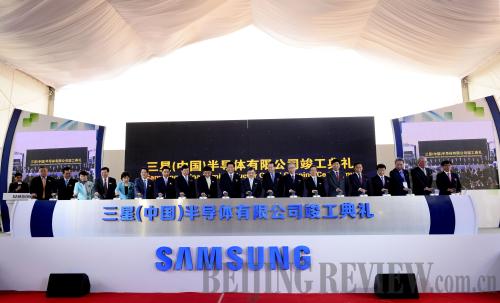

DAY TO REMEMBER: South Korean multinational electronics company Samsung launches a new semiconductor plant in Xi'an, capital of northwest China's Shannxi province, on May 9 (LIU XIAO)
The FTA, when finalized, is expected to help the two countries improve the mutual complementarity of their markets and strengthen the foundation for regional economic integration. The FTA negotiation is said to be one of the three major negotiations this year which will, to some extent, determine whether bilateral trade will reach the promised $300 billion next year. South Korea would thereby reinforce its position in the Chinese market and pave the way for China to set up FTAs with other world players.
Yang of the CIIS said the establishment of the China-South Korea FTA will not only increase the scale of bilateral trade in goods but also upgrade the "quality" of cooperation, providing new opportunities in emerging industries such as e-business, environmental protection as well as financial services.
Joining Xi's trip were over 250 Chinese entrepreneurs from the manufacturing, finance and IT sectors. Among them were Jack Ma, Executive Chairman of Alibaba Group, Ren Zhengfei, President of Huawei Technologies, and Li Yanhong, Board Chairman of search engine Baidu. The entrepreneurs have had their eye on potential business opportunities in the country which may arise once the bilateral FTA is established.
In addition, Yang said the FTA could also serve as an institutional support for bilateral economic ties. Moreover, the move will set a good example for the free trade framework of Northeast Asia. China, Japan and South Korea had agreed to set up a trilateral FTA, but due to certain issues—mainly concerning Japan—the trilateral FTA came to a deadlock.
"The China-South Korea FTA may kickstart the trilateral FTA talks, especially given the current chaotic state of political and security matters in the region," said Yang.
Professor Gao of the CFAU echoed Yang's remarks, adding that the China-South Korea FTA could even lay the groundwork for the Regional Comprehensive Economic Partnership (RCEP).
Comprising 10 ASEAN member nations as well as China, South Korea, Japan, India, Australia and New Zealand, the RCEP aims to integrate all of ASEAN's existing FTAs into one system. Upon its completion, it would account for over 30 percent of the world's GDP and cover about 45 percent of the global population.
Wei Zhijiang, a professor of South Korean studies with Zhongshan University in south China, said the FTA will bring concrete benefits to the peoples of both countries. "Once the FTA is established, South Koreans will have access to much cheaper agricultural products from the Chinese mainland while Chinese people will be able to purchase cheaper cars produced by Hyundai," he said.
Another tangible result of the visit was a memorandum of understanding between the two central banks on renminbi clearing in Seoul—a development that will push forward direct trading of the yuan with the won, the South Korean currency. The move would eliminate the need to exchange either currency into U.S. dollars when settling accounts, and it is believed that it would save transaction fees and hedge against foreign exchange volatility. In addition, China will grant an 80 billion yuan ($13 billion) quota of investment to South Korea under the Renminbi Qualified Foreign Institutional Investors (RQFII) program. Launched in 2011, the RQFII program allows foreign investors to invest in Chinese onshore stock and bond markets with offshore renminbi.
Observers said the new deal will also encourage the use of renminbi by banks and businesses in international transactions. Seoul's bid to become an offshore center for the renminbi has enjoyed increasing international popularity, backed by China's rapidly stabilizing economy.
"The direct trading of the yuan against the won would not only reduce the transaction costs for enterprises from the two countries, but could also be helpful for promoting the internationalization of the two currencies," Wei said.
In the last year, the world's second largest economy has reached agreements with Germany, Britain, France and Luxembourg to open local renminbi trading hubs, as the Chinese currency has been increasingly used in global trade and investment. The Chinese currency rose to become the seventh most used payment currency globally earlier this year. RMB payments grew by 29 percent month-on-month in March with a market share of 1.62 percent, up from 1.42 percent in February, according to global transaction service firm SWIFT.
Copyright ©1999-2018
Chinanews.com. All rights reserved.
Reproduction in whole or in part without permission is prohibited.